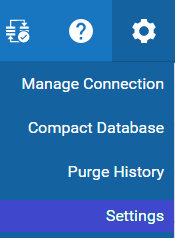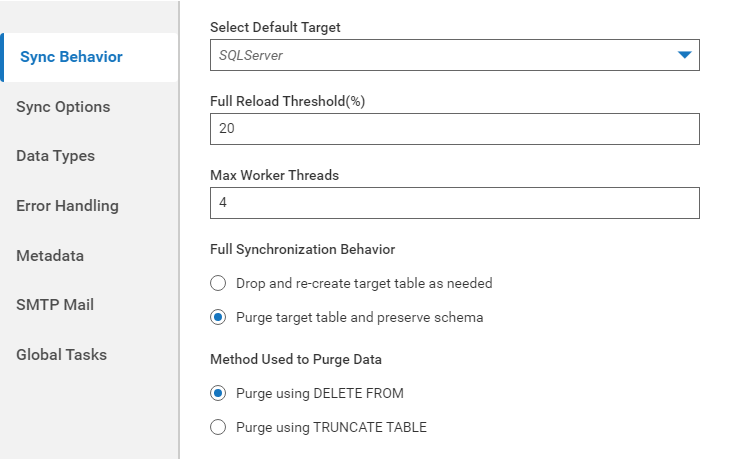DataSync settings are accessed from the Gear menu

The Sync Behavior page controls how DataSync behaves during the synchronization process

Select Default Target
This drop down box contains the list of all the databases defined in the CDD. The selected database will be used as the
target for Table Syncs and the default target for Transformation Syncs. The target database for transformations can be overridden
when defining transformations.
Full Reload Threshold(%)
The percentage amount that appears in Full Reload Threshold is the number that will determine if it is more efficient to
perform a full reload or an incremental update based on the percentage of rows changed in the source table. This number should
be very small, in the range of 3 to 20 percent.
Max Worker Threads
Enter a number in the Max Worker Threads text box. (Recommended = 4 threads per CPU on the Data Sync machine) The maximum
number is the number of threads on the PC (and also the number of servers on the host database server) that can be used when
processing the synchronization. For example, if there are 1000 tables of the same size, 1 out of 3 threads would process about
333 tables each. Increasing the number of threads uses more resources on the PC and on the host database server, but can also
increase performance.
Take note that increasing the thread count to a level that is too high can severely impact performance and possibly cause
failures. It is strongly recommended that you do not exceed ten threads per CPU available on the Data Synchronization machine
and also to consider the system's total memory, since each thread can allocate large blocks of memory when processing large
tables.
In order to test the effects of multiple threads, create a group and then synchronize the group.
Tip: A few tests with different threading values can determine a good level for Max Worker Threads for your system through examination
of the group synchronization time.
Full Synchronization Behavior
There are two methods to process a full synchronization. One is to drop and recreate the target table every time. The other
is to delete the data in the target table. When deleting data, we can either truncate the data or delete the data. Truncation is typically much faster, but not all systems support truncate. If you select truncation, and the target does not support
truncation, you will receive a warning and Delete will be used instead. An advantage to dropping and recreating the table is that changes in the source table will automatically
be reflected in the target and so the system is self-healing. However, there may be
customizations on the target server. In this case, we want to purge the data instead. Truncation, while faster, is not typically logged and therefore the user will have to redo a failed sync. Deletion works on every system, but is much slower than dropping and adding the schema or truncation.
If the target database does not support truncation, a warning appears for every table selected for deletion even though the
synchronization continues and succeeds.
There are two options for Full Synchronization Behavior:
Method Used to Purge Data:
There are two options for Purge target table and preserve schema: